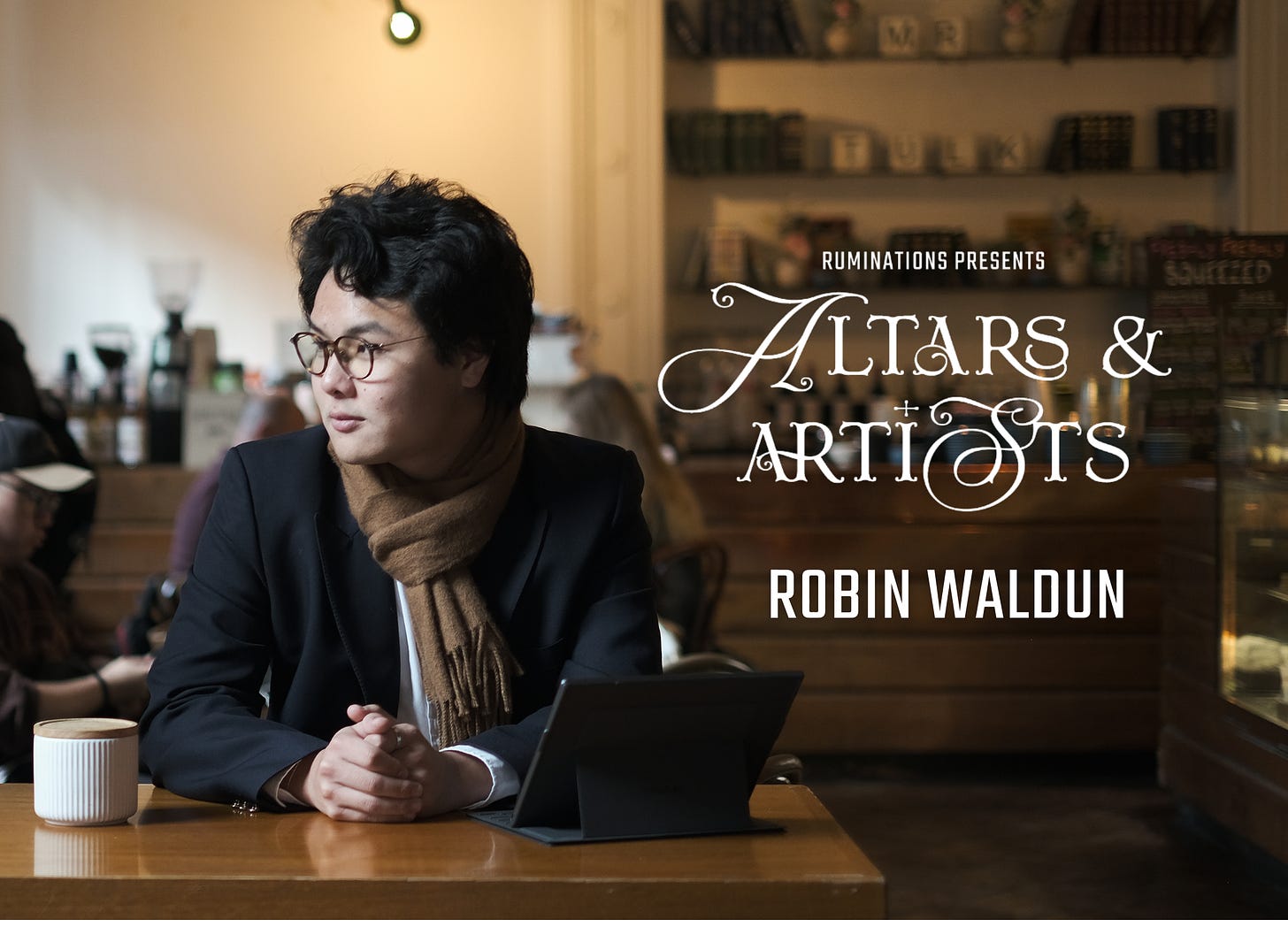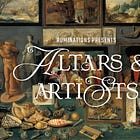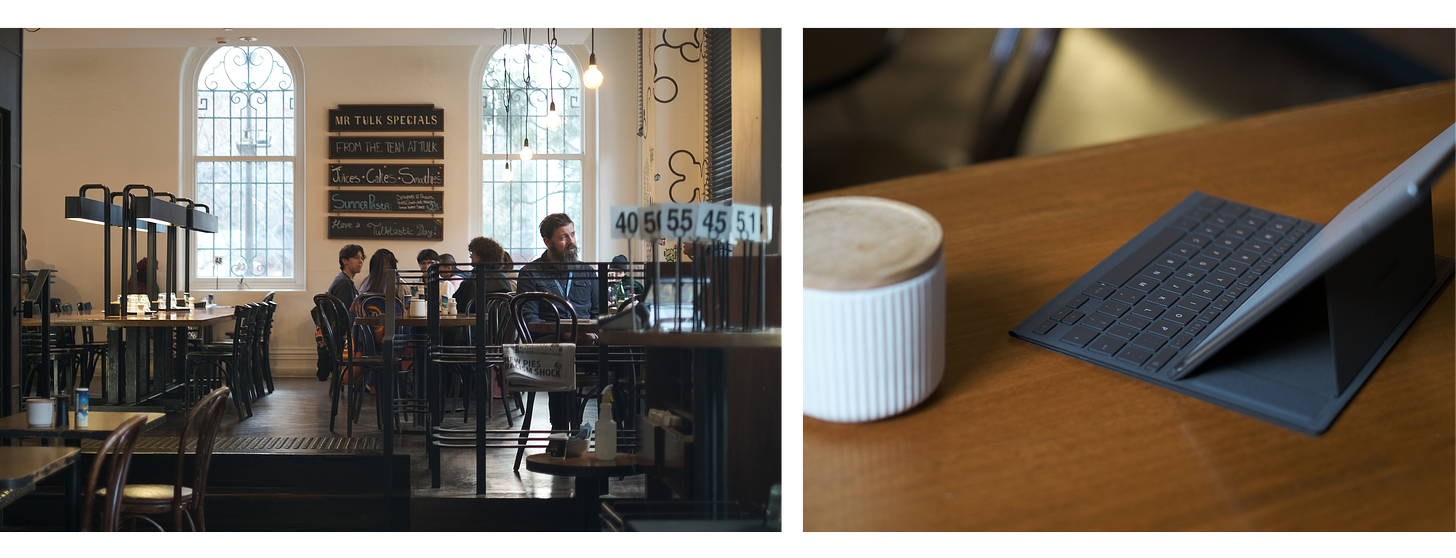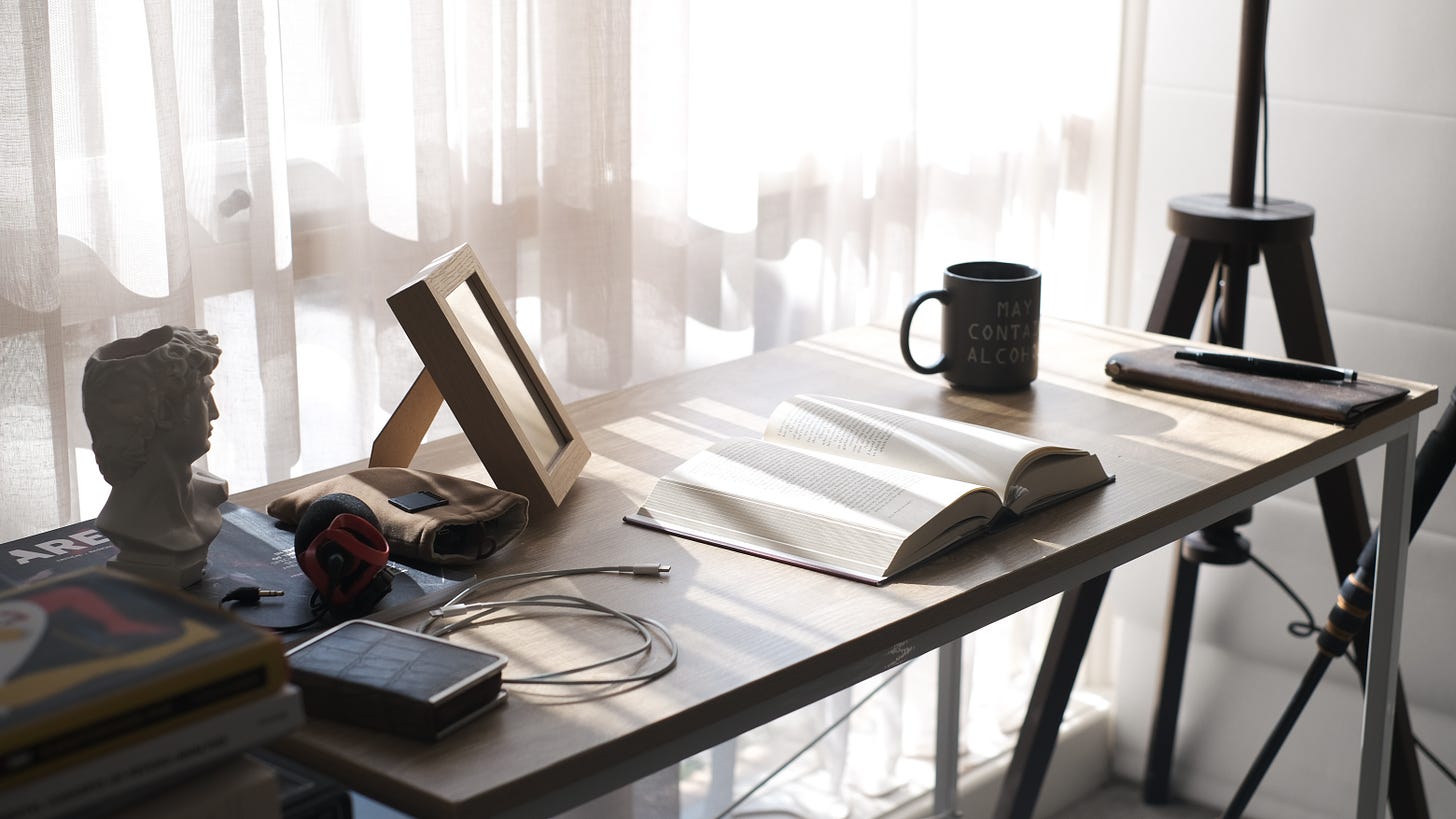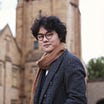Welcome to Altars & Artists, a monthly interview series divining the poetry of artists' spaces. Inspired by Gaston Bachelard’s book "The Poetics of Space" and Virginia Woolf’s extended essay "A Room of One’s Own", Altars & Artists delves into the creative spaces of contemporary artists to reveal the intimate worlds they operate within.
If you enjoy this series, please consider becoming a paid subscriber—doing so unlocks an extended cut of each interview, including a prompt made especially for you by the guest. Your contribution also keeps Ruminations running & this writer at her desk ❧
New to this series? Be sure to check out the intro post below:
Please welcome Altars & Artist guest — Robin Waldun ❧
Robin Waldun (he/him) is a researcher, YouTuber and author of the popular newsletter: A Mug of Insights. His work can be boiled down to one question: what is an education in the humanities for? And his projects closely document his investigations in writing and multi-media.
Robin was one of the first supporters of Ruminations—if you were here in the early days, you might remember the open letters we shared reflecting on our travels abroad. He is also a great inspiration to me personally; his dedication to lifelong learning and his passion for the humanities have often inspired me in my own academic and creative ventures. It’s a pleasure to welcome him now to Altars & Artists—enjoy! <3
Questions & Curiosities
Welcome to Ruminations Robin! Can you begin by telling us about yourself and what you do?
RCW: Thanks Caitlin! Greetings from Melbourne, Australia. I think everything I do falls under the umbrella of being an educator in the humanities. The work takes on different flavours: YouTube videos, newsletter articles, Instagram Reels and recently, a podcast. The main goal, however, is to give the public an accessible introduction to the humanities without getting caught up in obscurity.
You inhabit an interesting space between academia and creatively expressive forms. What led you to begin sharing your knowledge and experiences through videography and, later on, creative non-fiction?
RCW: Funny story. My interest in creating videos started with a summer job. A family friend of mine went to film school and needed an extra grip on his sets. What followed was an entire month of learning everything I could about lighting, editing and using an industry-grade camera. After that summer, though he had wrapped up the shoot, I was far from done with creating videos. I realised what I gained from that job was far more valuable than pocket money. In today’s world, knowing how to use a camera and edit videos is a superpower, so I kept practising my love for videography long after the job.
A few years later, I found myself in year 11 studying subjects that made me want to poke my eyes out with bicycle spokes. I didn’t have a problem with what I was learning per se, but the dry, repetitive rote learning aspects of K-12 education stepped on my nerves. One night, after a long study session, I stormed home, turned on my camera and recorded the video that changed the course of my career: Why I Don’t Care About Grades Anymore.
The video did well and a lot of people seemed to agree with my message: study for the sake of understanding, not grades. What followed was a period of obsession. I recorded and uploaded (on average) 3 videos a week and collected a catalogue of over 200 videos in two years (I privated most of my earlier works). And as I created more videos, my niche naturally aligned with my obsession: how can we use knowledge to change lives instead of keeping them locked up in academia?
In 2020, I realized that my work on YouTube demanded all of my attention and energy. I left my day job as a bookseller and threw everything into sharing my intellectual obsessions with my audience. Four years later, though I had graduated from university with Honours with a successful content creation business, I still found myself with more questions than answers. So around this time, my focus gradually shifted away from video to writing.
This is when I decided to start A Mug of Insights. It seemed like the perfect place to practice articulating my insights in writing, and the goal is to combine my academic training and communication skills to fulfil the same old goal: making lifelong learning accessible to all.
I have a lifelong admiration and love for the artistry of cinematography myself and think it’s wonderful that you chose to combine your interests instead of leaving one behind. Does your creative process differ between drafting and producing YouTube videos and writing and editing articles for A Mug of Insights? Have you found that writing regularly here on Substack has changed your approach to the way you learn, process your ideas, or teach?
RCW: When I first started making YouTube videos, I hated scripting. In most of my earlier videos, I only jotted down brief outlines before hitting record. I guess I was in love with the spontaneous connections when I was forced in front of the camera. It’s like jazz in a way. Miles Davis once said that performance for him was to practice in front of an audience. He wanted the stuff he didn’t know to come out in the moment. In retrospect that was the philosophy I lived by when I first started.
But after a while, I saw the limitations of that approach. If there’s one thing university taught me, it is the discipline to polish an idea over a long period of time. I started tempering my insights to see what they would turn into months later. After a while, it became more satisfying to work on an idea for a few months instead of pushing it out immediately after conceiving it.
This is why I started shifting my focus away from video to writing. Writing disciplines thinking because if a thought isn’t mature enough, it would sound quite stupid on the page. Whereas with speaking, anyone can quack about and assume that they’re smarter than they are. The resistance to writing also allowed me to take an idea with me on the train, on a run or when I’m having a meal. I’ve to admit that most of my eureka moments came to me when I was scoffing down a cheap meal at this run-down Japanese Don restaurant near campus. If I had finished that train of thoughts in the library, however, then the writing would’ve remained a shrivelled husk.
Nowadays I spend most of my time writing. Occasionally I would convert a successful post into a video and they’ve all done quite well, especially the one on Byung-Chul Han’s The Burnout Society. I spent a lot less time rambling and I think writing might’ve unintentionally disciplined my thought process and presentation. So yes, writing on Substack permanently altered my workflow.
In the past, you’ve shared your love of cafes and what you call “the art of lingering”, expressing that while much of the artistic process is both frivolous and time-consuming, these things are essential to creation. I think you actually capture it quite beautifully when you joke “…we have to rush into an empty café early in the morning before they can pack away the privilege of lingering”. What is it that draws you to public spaces like cafes? What does the experience of lingering in a cafe offer that returning to your own creative space doesn’t?
RCW: I owe that line to Byung-Chul Han’s books: Vita Contemplativa and The Palliative Society so let’s start there. Han argued that good ideas need to persist through resistance, or else they’ll just remain mental circle jerks. In his jargon, he called this circle-jerk an excessive self-reference and it’ll produce both detached thinkers and weak ideas.
I like public spaces (cafes, libraries, etc) because they offer resistance to my thoughts. I might see a friend and waste the whole afternoon chatting. I might get lost in the bookshop attached to the library and empty my wallet. But I see these interruptions as blessings. They trim away the obscure excess because if an idea is good and strong, it should withstand these interruptions and re-emerge in a more vigorous tone. I guess this also gave my writing that engaging quality, but I’ll leave the readers to be the judge. Also, sometimes when I’m in a really good place, I even get this strange feeling that the world is writing itself through me. I disappear into the public space and this is usually when I produce breakthroughs. In a solitary space, however, I’m more often than not tangled up in my head, unable to write anything.
In short, I like to think out in the open. Nietzsche advised in Ecce Homo that we should “sit as little as possible” and distrust “any idea that was not born in the open air and of free movement”. Hence during a typical workday, I like to shuffle from a cafe to the library, from the library to the park. And after I’ve gathered enough material to work with, I’ll return to my room and temper those scattered ideas into writing.
That moment when you transform from writer to vessel really is one of the most sacred parts of the writing experience. It reminds me of a quote by Alan Watts: “You are an aperture through which the universe is looking at and exploring itself.”
When the coffee mug is empty and the cafe closed, where do you return to work on your creative projects?
RCW: I return to my mad scientist’s lab. It’s a simple set-up: the desk is from my mom’s old office and I stacked it against the window because I still like to maintain contact with the outside world.
There are always stacks of books on this desk because I like to pull precise citations from them. This is the academic in me. I need the information to be exact, sometimes down to the edition & translation I’m using, which is why I never bother to return books back to the shelf until I’ve finished a writing project. If I had to run to the bookshelf, find the page and copy a citation down, the writing would lose its flow.
Normally the space is quite neat and I like to keep a pitcher of water next to me. But when I was writing my Honours thesis, the desk would give any well-intentioned neat freak a panic attack but it made sense to me. I think that a pristine, Instagram-perfect desk, though clean, would always suck away all that is beautiful and chaotic about creativity, whereas a mess can always be cleaned up after a project.
I want to congratulate you for recently completing your Honours dissertation on literary theory! Do you find your artistry blends into your academic work and vice versa? Do you have artistic influences who have softened the rigidity of your academic approach and/or academic influences who have complimented your creative approach? How does your creative space honour both of these interests?
RCW: I think rigour and artistry in this case is a false dichotomy. The perceived rigidity is only a matter of form; a shared language in academia if you will. Once we get past the initial discomfort, we find that some of the most rigorous theoretical works are passionately argued and beautifully crafted.
One of my heroes is Susan Sontag and her writing is a fine example of this. It contains the erudition you’d expect from a Harvard graduate, yet there’s an urgency that edges into anger between the lines. Whereas someone like Bertrand Russell, despite being one of the most influential analytic philosophers in the 20th Century, retained his delightful wit in his later works. After a while, you’d realise that what we call “rigorous academic writing” is actually a cohort of very different voices. Some of them make me want to scream while others wrack me with the seven jealousies. I sometimes steal a page out of the books of those pure mathematics wizards (their building is next to the Arts Precinct): there is always beauty and artistry, even in the most technical and theoretical fields.
I think my goal is to embody both style and rigour, and I have to thank my thesis supervisor for tempering my style. He challenged and trimmed away all the fluff in my thesis, and over time this process gave me my writing voice. Now when I write something, I strive to strike a balance between rigor and storytelling, and this is why I start and end a piece with personal anecdotes.
Also, working in a public space (as mentioned above) grounds my writing, too. But in short, I think over time I learned to place myself in the mind of a busy reader who doesn’t need a long-winded lecture, but a direct and relatable voice.
“I think rigour and artistry in this case is a false dichotomy. The perceived rigidity is only a matter of form; a shared language in academia if you will. Once we get past the initial discomfort, we’d find that some of the most rigorous theoretical works are passionately argued and beautifully crafted.”
In A Room of One’s Own, Woolf states “Intellectual freedom depends upon material things. Poetry depends upon intellectual freedom.” As someone with one foot on a university campus and the other online, can you speak to the importance of both the material spaces provided by universities, and the digital spaces we can access through technology?
RCW: This goes back to the point of lingering spaces. For context, my university is near the edge of the CBD in Melbourne. There’s less noise pollution and a lot more third spaces, creating a calm environment for students to hang around after class.
The CBD, however, does not encourage lingering. The benches are uncomfortable and cafes all close up at around 5 pm. All I can think about is: how do I get to X without yelling at someone? It’s a transactional space and the pace doesn’t really allow organic connections. This is why I prefer to work in places designed for lingering: a public library, a university seminar room or a cafe that closes late. And I find that specific physical spaces are important for that very reason: they carve out the emptiness that allows ideas to germinate instead of forcing you into a pre-assigned purpose.
The internet, however, is a weird hybrid. It’s a space that’s purposelessly purposeful and it glues us down into one place but permits no lingering. Every interaction is a transaction of data and every page view is new incoming data. Granted, we have any information at our fingertips, but the internet allows no time to think, eventually reducing all content into a frenzied repetition.
To remedy this, I think when it comes down to digital spaces, the role of writers and thinkers on the internet is to carve out empty spaces for people to slow down. We are the brownstone structures that encourage our readers to rest in the archways and think twice about what they’re reading. Doing this is incredibly difficult but the rise of long-form content on YouTube seems like a good start. I love those video essays that keep me thinking for days. That’s what lingering looks like on the internet: sustained attention on one topic followed by a rush of insights near the end.
There’s still a lot of work to be done, especially in the sphere of balancing internet usage with learning, but I find that my favourite things on the internet direct me away from the screen into living a richer life.
I love this reflection—Ruminations was borne of that very desire to create something slow and reflective for both myself and my readers. While I can’t speak for my readers, I do think it’s helping me inch closer to that balance.
Thank you so much for sharing your altars and insights with us Robin! Before we move on to the next segment for our paid subscribers, can you give us a glimpse into the projects you’re currently working on?
RCW: Thank you for having me, Caitlin! I had a blast.
I’m currently editing my thesis into a journal article and I’ll try to get it published this year. In it, I developed a theoretical framework called Amorous Reading to liberate new possibilities for literary criticism and I’m very excited to share it with the world. I’m also head-deep in Beth Driscoll’s work: What Readers Do as a part of my Ph.D. application for 2025.
Besides that and writing regular posts on Substack, I recently launched a QnA podcast with my newsletter and it’s been a passion project come true. It feels great to hear the voices of my subscribers and give something back.
Then again, thank you so much for having me. Your newsletter always inspires me to infuse more poetry of the everyday into my writing.
Thank you, Robin, and all the best in getting your article published!
Keep up to date with Robin’s latest insights and work:
Instagram: @r.c.waldun
YouTube: RCWaldun
Website: https://rcwaldun.com/
Substack:
The Extended Cut
Before you leave us with your creative prompt, we have a few rapid-fire questions for you Robin…
Keep reading with a 7-day free trial
Subscribe to Ruminations to keep reading this post and get 7 days of free access to the full post archives.





